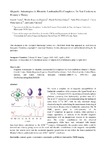Mostrar o rexistro simple do ítem
Magnetic anisotropies in rhombic lanthanide(III) complexes do not conform to Bleaney’s theory
| dc.contributor.author | Castro, Goretti | |
| dc.contributor.author | Regueiro-Figueroa, Martín | |
| dc.contributor.author | Esteban-Gómez, David | |
| dc.contributor.author | Pérez-Lourido, Paulo | |
| dc.contributor.author | Platas-Iglesias, Carlos | |
| dc.contributor.author | Valencia, Laura | |
| dc.date.accessioned | 2017-03-31T09:03:52Z | |
| dc.date.available | 2017-03-31T09:03:52Z | |
| dc.date.issued | 2016-04-04 | |
| dc.identifier.citation | Magnetic Anisotropies in Rhombic Lanthanide(III) Complexes Do Not Conform to Bleaney’s Theory. Goretti Castro, Martín Regueiro-Figueroa, David Esteban-Gómez, Paulo Pérez-Lourido, Carlos Platas-Iglesias, and Laura Valencia. Inorganic Chemistry 2016 55 (7), 3490-3497. DOI: 10.1021/acs.inorgchem.5b02918 | es_ES |
| dc.identifier.issn | 0020-1669 | |
| dc.identifier.issn | 1520-510X | |
| dc.identifier.uri | http://hdl.handle.net/2183/18349 | |
| dc.description.abstract | [Abstract] We report a complete set of magnetic susceptibilities of lanthanide complexes with a macrocyclic ligand based on a 3,6,10,13-tetraaza-1,8(2,6)-dipyridinacyclotetradecaphane platform containing four hydroxyethyl pendant arms (L1). The [LnL1]3+ complexes are isostructural along the lanthanide series from Ce3+ to Yb3+, with the only structural change observed along the series being the monotonous shortening of the Ln–donor distances due to lanthanide contraction. The 1H NMR spectra point to a D2 symmetry of the [LnL1]3+ complexes in aqueous solution, which provides a unique opportunity for analysis of the rhombic magnetic anisotropies with an unequivocal location of the magnetic axes. The contact contributions for the observed paramagnetic shifts have been estimated with density functional theory calculations on the [GdL1]3+ complex. Subsequently, the pseudocontact shifts could be factored out, thereby giving access to the axial and rhombic contributions of the magnetic susceptibility tensor. Our results show that the calculated magnetic anisotropies do not follow the trends predicted by Bleaney’s theory, particularly in the case of Ho3+ and Er3+ complexes. | es_ES |
| dc.description.sponsorship | Ministerio de Economía y Competitividad; CTQ2013-43243-P | es_ES |
| dc.description.sponsorship | Ministerio de Ciencia e Innovación; CTQ2011-24487 | es_ES |
| dc.language.iso | eng | es_ES |
| dc.publisher | American Chemical Society | es_ES |
| dc.relation.uri | https://doi.org/10.1021/acs.inorgchem.5b02918 | es_ES |
| dc.rights | This document is the Accepted Manuscript version of a Published Work that appeared in final form in "Inorganic Chemistry", copyright © American Chemical Society after peer review and technical editing by the publisher. | es_ES |
| dc.subject | Contrast agents | es_ES |
| dc.subject | Coordination compounds | es_ES |
| dc.subject | Gadolinium | es_ES |
| dc.subject | Lanthanides | es_ES |
| dc.subject | NMR imaging | es_ES |
| dc.title | Magnetic anisotropies in rhombic lanthanide(III) complexes do not conform to Bleaney’s theory | es_ES |
| dc.type | info:eu-repo/semantics/article | es_ES |
| dc.rights.access | info:eu-repo/semantics/openAccess | es_ES |
| UDC.journalTitle | Inorganic Chemistry | es_ES |
| UDC.volume | 55 | es_ES |
| UDC.issue | 7 | es_ES |
| UDC.startPage | 3490 | es_ES |
| UDC.endPage | 3497 | es_ES |
Ficheiros no ítem
Este ítem aparece na(s) seguinte(s) colección(s)
-
GI-REACT! - Artigos [113]






